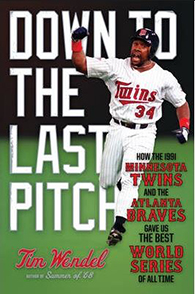 Down To The Last Pitch – How the 1991 Minnesota Twins and the Atlanta Braves Gave Us the Best World Series of All Time
Down To The Last Pitch – How the 1991 Minnesota Twins and the Atlanta Braves Gave Us the Best World Series of All Time
By Tim Wendel
2014 DA CAPO PRESS
$25.99
The 1991 World Series, matching the Minnesota Twins and the Atlanta Braves, will go down as one of the most exciting ever played. The 1991 Fall Classic went the full seven games, ending in a 1-0, ten-inning win for the Twins. Three games went extra innings, four came down to the final at bat and five were decided by a single run. The Series was filled with tension and turning points (close plays at the plate, critical double plays, controversial umpires’ calls, base-running blunders, game-saving catches, timely strikeouts). ESPN, in celebrating the 100th Anniversary of the World Series, named the 1991 matchup the “greatest World Series ever.”
The 1991 Series had more going for it than dramatic games and avid home crowds (all the games were won by the home team). It was, in fact, an historic event even before the first pitch was thrown. Never in major league history had a team gone from last place to pennant winner (punching a ticket to the Fall Classic) in a single year. In 1991, both World Series’ participants had accomplished that feat.
If ever a World Series deserved its own book, it was the 1991 match up. Fortunately, for baseball fans, Tim Wendel (award-winning author, one of USA Today Baseball Weekly’s founding editors, exhibit advisor to the Baseball Hall of Fame and, as evidenced by his prose, a knowledgeable and passionate baseball fan) has given us that book in the form of the recently released Down To The Last Pitch – How the 1991 Minnesota Twins and the Atlanta Braves Gave Us the Best World Series of All Time.
Down To The Last Pitch lives up to the events it describes. Wendel couples his journalistic skills with an understanding and appreciation of the national pastime to take readers deep into the 1991 World Series – not just into the ballpark, but right into the dugout and onto the field. Down To The Last Pitch provides an inside look at what was going on behind the scenes and in the minds of the players, managers and coaches as – game by game – the tension ratcheted up. Wendel presents this historic Series in a combination of his own words and observations and those of its participants. For baseball fans, it’s a story worth telling, reading and remembering.
As Atlanta third baseman and 1991 National League MVP Terry Pendleton said of the Series, “Every pitch, every strike, every ball, every inning – everything mattered in every game.”
Just how much it all mattered comes through in Wendel’s account of Minnesota catcher Brian Harper’s thoughts during a break in the action after the Twins had intentionally walked David Justice to load the bases with one out and the score tied at 0-0 in the top of the eighth inning of Game Seven. Wendel lets Harper describe the pressure in his own words: “That’s when I envisioned a come-backer to Jack (Morris), he throws it to me at home plate, then I airmail one past (Kent) Hrbek into right field. We lose the Series and I’m the goat of all time. I would be the next Bill Buckner. I literally thought this after we walked David Justice. So, I then I’m thinking, ‘Okay, get that thought out of your head. Lord, please help me relax here and let me do my job.’”
Harper was apparently successful in pushing that negative vision from is mind. And, it’s a good thing, because his nightmare (just slightly modified) began to play out right before his eyes. The Braves’ next hitter, Sid Bream, hit a grounder to Hrbek at first base, who fired to Harper for the force out at the plate, leaving Harper to make that inning-ending (or game-losing) home-to-first double play throw- which, as we all know, he did successfully.
Wendel’s game-by-game description of the Series provides plenty of these very human insights into the action, adding color and depth to his accounting. He includes the often told story of how Twins’ starter Jack Morris (who threw a ten-inning, complete game shutout in Game Seven) had to lobby manager Tom Kelly to stay in the game after the ninth inning. He ends the tale with Kelly’s submission and comment, “Oh hell. It’s only a game.” Down To The Last Pitch adds a little context to Morris’ grit and determination, having already noted that Morris (described as having “the air of an ornery, aging gunslinger”) was disgruntled after being lifted for a pinch-hitter in the sixth inning of Game Four (tied 1-1 at the time and eventually won 3-2 by the Braves). Morris later told Sports Illustrated, “TK screwed up by taking me out. We would have won it.” Nobody was taking the ball from Morris’ hand in the deciding game.
Down To The Last Pitch also uses the flow of the game as a natural bridge to observations on, not just the players involved, but baseball itself. The reader gains insight into such player-related topics as John Smoltz’ 1991 turnaround (a 2-11 won-lost record in the first half and a 12-2 record in the second half), how reliever Rick Aguilera ended up as the first pitcher used as a pinch hitter in the World Series since 1965, and events that shaped the baseball lives of many of the players who took the field for the Series (like Mike Lemke’s childhood pickup games on the grounds of the Mohawk Valley Psychiatric Center or the impact of the lights from the Twins’ original Metropolitan Stadium shining into the bedroom window of a young Kent Hrbek).
Wendel also uses game action to lead into more general commentary on baseball. The crack of the bat on Twins’ number-nine hitter Greg Gagne’s Game One home run, for example, takes Wendel back a previous conversation with Hall of Famer Frank Robinson (who hit 586 MLB home runs). Robinson described the sound of a home run as “Like you’re out in the woods and you step on a branch. A dry branch. It’s that snap that goes just so.” That’s the sound Wendel reports hearing, even above the crowd, on Gagne’s home run. That distinctive snap spurred him to share Robinson’s thoughts not only on the “sound” of a home run, but also on its excitement. In Robinson’s words, “Nothing else offers the kind of excitement a home run does. Not even a perfect game. Because a home run is instant – it’s so surprising.”
Down to the Last Pitch also includes commentary on factors affecting the Series’ outcome that may have escaped the average fan. Wendel delves, for example, into the unavailability of speedsters Otis Nixon (drug-related suspension) and Deion Sanders (Atlanta Falcons’ football training camp) – two Braves’ players with potentially game-changing speed. Few remember that Nixon, out for the Series, hit .297 with 72 stolen bases in 124 games in 1991.
Ultimately, Down To The Last Pitch is a great read not just for Twins and Braves fans – although it is a must for followers of those teams – but for any fans who want to get closer to the game. I was lucky enough to attend the Twins’ home games in the 1991 Series and, after reading Down To The Last Pitch, I feel “closer” to the action than ever.
And, there is even more. Once you’ve completed Wendel’s account of the seven exciting contests that made up the 1991 World Series, there is – like an extra inning game – even more baseball to come. The book includes two Appendices: One covering what happened after the Series to many of the principals involved (and other notables from the 1991 season); and a second outlining a dozen great World Series moments.
In short, Down To The Last Pitch has something for baseball fans down to the last page.
Other baseball books by Tim Wendel you may enjoy: Summer of 68: The Season that Changed Baseball and America Forever (reviewed here); High Heat: The Secret History of the Fastball and the Improbable Search for the Fastest Pitcher of All Time; Far From Home: Latino Baseball Players in America; The New Face of Baseball: The One-Hundred-Year Rise and Triumph of Latinos in America’s Favorite Sport.





